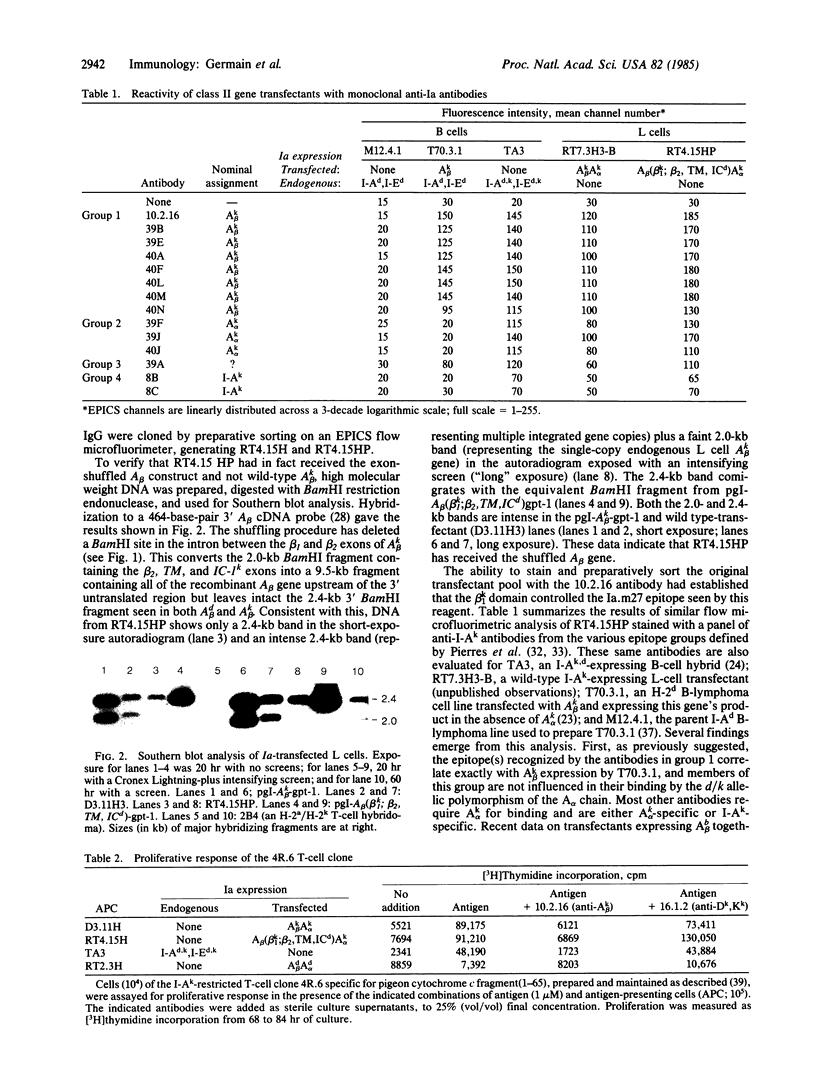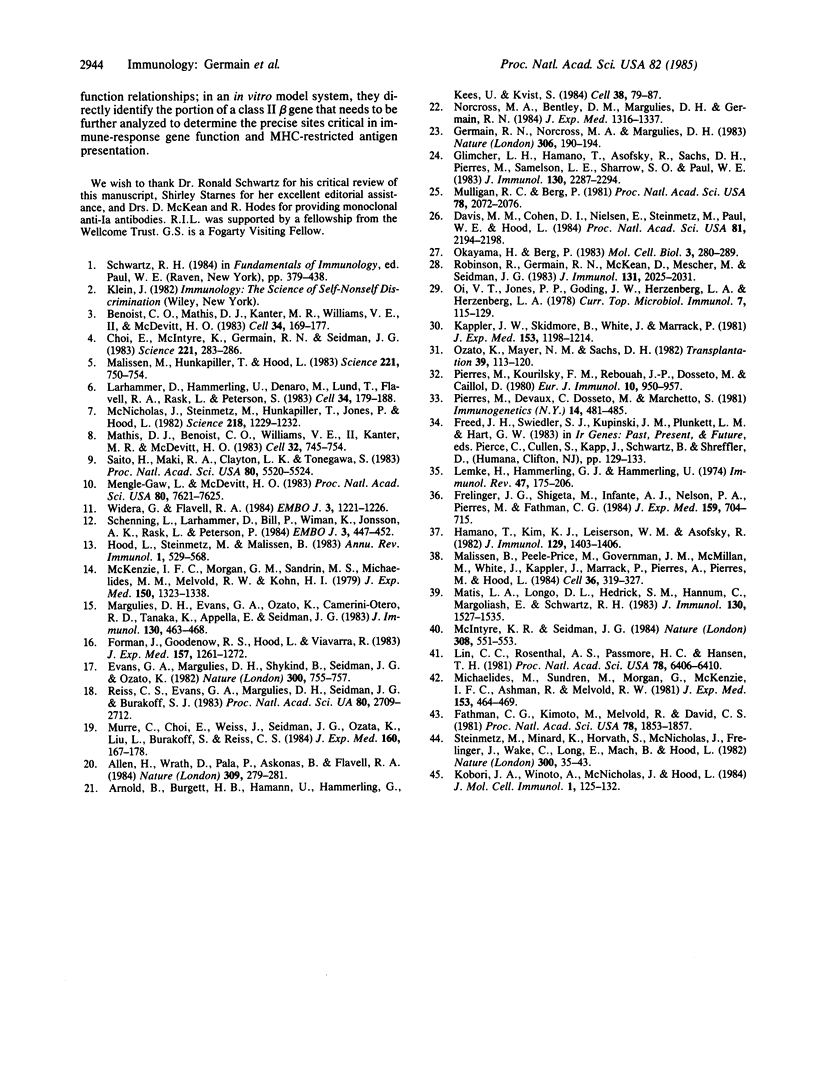Abstract
To investigate the role of the highly polymorphic amino-terminal (beta 1) domain of the class II major histocompatibility polypeptide A beta during recognition by T cells and antibodies, "exon-shuffling" was carried out between genomic recombinant DNA clones of Ak beta and Ad beta to generate a hybrid gene containing Ak beta exons for the amino-terminal domain followed by the Ad beta exons for the remainder of the molecule. L-cell gene transfectants expressing this hybrid A beta gene in combination with Ak alpha were compared to L cells expressing wild-type Ak beta Ak alpha dimers in tests of antigen-presentation to T-cell clones and hybridomas and for staining by a panel of anti-I-Ak-specific monoclonal antibodies. These antibodies were also tested for their reactivity with a B-lymphoma transfectant expressing Ak beta in the absence of Ak alpha. The results showed no qualitative differences in either T-cell or antibody-mediated recognition of I-Ak molecules containing either the exon-shuffled or wildtype Ak beta. Together with the data involving the B cell transfectant expressing only Ak beta, these results map control of the A beta contribution to the immunologically relevant determinants of I-Ak to the highly polymorphic amino-terminal domain and indicate little, if any, contribution to allele-specific recognition by amino acid sequence variations in the remaining portions of the A beta polypeptide.
Full text
PDF




Images in this article
Selected References
These references are in PubMed. This may not be the complete list of references from this article.
- Allen H., Wraith D., Pala P., Askonas B., Flavell R. A. Domain interactions of H-2 class I antigens alter cytotoxic T-cell recognition sites. Nature. 1984 May 17;309(5965):279–281. doi: 10.1038/309279a0. [DOI] [PubMed] [Google Scholar]
- Arnold B., Burgert H. G., Hamann U., Hämmerling G., Kees U., Kvist S. Cytolytic T cells recognize the two amino-terminal domains of H-2 K antigens in tandem in influenza A infected cells. Cell. 1984 Aug;38(1):79–87. doi: 10.1016/0092-8674(84)90528-2. [DOI] [PubMed] [Google Scholar]
- Benoist C. O., Mathis D. J., Kanter M. R., Williams V. E., 2nd, McDevitt H. O. Regions of allelic hypervariability in the murine A alpha immune response gene. Cell. 1983 Aug;34(1):169–177. doi: 10.1016/0092-8674(83)90147-2. [DOI] [PubMed] [Google Scholar]
- Choi E., McIntyre K., Germain R. N., Seidman J. G. Murine I-A beta chain polymorphism: nucleotide sequences of three allelic I-A beta genes. Science. 1983 Jul 15;221(4607):283–286. doi: 10.1126/science.6407114. [DOI] [PubMed] [Google Scholar]
- Davis M. M., Cohen D. I., Nielsen E. A., Steinmetz M., Paul W. E., Hood L. Cell-type-specific cDNA probes and the murine I region: the localization and orientation of Ad alpha. Proc Natl Acad Sci U S A. 1984 Apr;81(7):2194–2198. doi: 10.1073/pnas.81.7.2194. [DOI] [PMC free article] [PubMed] [Google Scholar]
- Evans G. A., Margulies D. H., Shykind B., Seidman J. G., Ozato K. Exon shuffling: mapping polymorphic determinants on hybrid mouse transplantation antigens. Nature. 1982 Dec 23;300(5894):755–757. doi: 10.1038/300755a0. [DOI] [PubMed] [Google Scholar]
- Fathman C. G., Kimoto M., Melvold R., David C. S. Reconstitution of Ir genes, Ia antigens, and mixed lymphocyte reaction determinants by gene complementation. Proc Natl Acad Sci U S A. 1981 Mar;78(3):1853–1857. doi: 10.1073/pnas.78.3.1853. [DOI] [PMC free article] [PubMed] [Google Scholar]
- Forman J., Goodenow R. S., Hood L., Ciavarra R. Use of DNA-mediated gene transfer to analyze the role of H-2Ld in controlling the specificity of anti-vesicular stomatitis virus cytotoxic T cells. J Exp Med. 1983 Apr 1;157(4):1261–1272. doi: 10.1084/jem.157.4.1261. [DOI] [PMC free article] [PubMed] [Google Scholar]
- Frelinger J. G., Shigeta M., Infante A. J., Nelson P. A., Pierres M., Fathman C. G. Multiple functional sites on a single Ia molecule defined using T cell clones and antibodies with chain-determined specificity. J Exp Med. 1984 Mar 1;159(3):704–715. doi: 10.1084/jem.159.3.704. [DOI] [PMC free article] [PubMed] [Google Scholar]
- Germain R. N., Norcross M. A., Margulies D. H. Functional expression of a transfected murine class II MHC gene. Nature. 1983 Nov 10;306(5939):190–194. doi: 10.1038/306190a0. [DOI] [PubMed] [Google Scholar]
- Glimcher L. H., Hamano T., Asofsky R., Sachs D. H., Pierres M., Samelson L. E., Sharrow S. O., Paul W. E. IA mutant functional antigen-presenting cell lines. J Immunol. 1983 May;130(5):2287–2294. [PubMed] [Google Scholar]
- Hamano T., Kim K. J., Leiserson W. M., Asofsky R. Establishment of B cell hybridomas with B cell surface antigens. J Immunol. 1982 Oct;129(4):1403–1406. [PubMed] [Google Scholar]
- Hood L., Steinmetz M., Malissen B. Genes of the major histocompatibility complex of the mouse. Annu Rev Immunol. 1983;1:529–568. doi: 10.1146/annurev.iy.01.040183.002525. [DOI] [PubMed] [Google Scholar]
- Kappler J. W., Skidmore B., White J., Marrack P. Antigen-inducible, H-2-restricted, interleukin-2-producing T cell hybridomas. Lack of independent antigen and H-2 recognition. J Exp Med. 1981 May 1;153(5):1198–1214. doi: 10.1084/jem.153.5.1198. [DOI] [PMC free article] [PubMed] [Google Scholar]
- Kobori J. A., Winoto A., McNicholas J., Hood L. Molecular characterization of the recombination region of six murine major histocompatibility complex (MHC) I-region recombinants. J Mol Cell Immunol. 1984;1(2):125–135. [PubMed] [Google Scholar]
- Larhammar D., Hammerling U., Denaro M., Lund T., Flavell R. A., Rask L., Peterson P. A. Structure of the murine immune response I-A beta locus: sequence of the I-A beta gene and an adjacent beta-chain second domain exon. Cell. 1983 Aug;34(1):179–188. doi: 10.1016/0092-8674(83)90148-4. [DOI] [PubMed] [Google Scholar]
- Lemke H., Hämmerling G. J., Hämmerling U. Fine specificity analysis with monoclonal antibodies of antigens controlled by the major histocompatibility complex and by the Qa/TL region in mice. Immunol Rev. 1979;47:175–206. doi: 10.1111/j.1600-065x.1979.tb00293.x. [DOI] [PubMed] [Google Scholar]
- Lin C. C., Rosenthal A. S., Passmore H. C., Hansen T. H. Selective loss of antigen-specific Ir gene function in IA mutant B6.C-H-2bm12 is an antigen presenting cell defect. Proc Natl Acad Sci U S A. 1981 Oct;78(10):6406–6410. doi: 10.1073/pnas.78.10.6406. [DOI] [PMC free article] [PubMed] [Google Scholar]
- Malissen B., Price M. P., Goverman J. M., McMillan M., White J., Kappler J., Marrack P., Pierres A., Pierres M., Hood L. Gene transfer of H-2 class II genes: antigen presentation by mouse fibroblast and hamster B-cell lines. Cell. 1984 Feb;36(2):319–327. doi: 10.1016/0092-8674(84)90225-3. [DOI] [PubMed] [Google Scholar]
- Malissen M., Hunkapiller T., Hood L. Nucleotide sequence of a light chain gene of the mouse I-A subregion: A beta d. Science. 1983 Aug 19;221(4612):750–754. doi: 10.1126/science.6410508. [DOI] [PubMed] [Google Scholar]
- Margulies D. H., Evans G. A., Ozato K., Camerini-Otero R. D., Tanaka K., Appella E., Seidman J. G. Expression of H-2Dd and H-2Ld mouse major histocompatibility antigen genes in L cells after DNA-mediated gene transfer. J Immunol. 1983 Jan;130(1):463–470. [PubMed] [Google Scholar]
- Mathis D. J., Benoist C. O., Williams V. E., 2nd, Kanter M. R., McDevitt H. O. The murine E alpha immune response gene. Cell. 1983 Mar;32(3):745–754. doi: 10.1016/0092-8674(83)90060-0. [DOI] [PubMed] [Google Scholar]
- Matis L. A., Longo D. L., Hedrick S. M., Hannum C., Margoliash E., Schwartz R. H. Clonal analysis of the major histocompatibility complex restriction and the fine specificity of antigen recognition in the T cell proliferative response to cytochrome C. J Immunol. 1983 Apr;130(4):1527–1535. [PubMed] [Google Scholar]
- McIntyre K. R., Seidman J. G. Nucleotide sequence of mutant I-A beta bm12 gene is evidence for genetic exchange between mouse immune response genes. Nature. 1984 Apr 5;308(5959):551–553. doi: 10.1038/308551a0. [DOI] [PubMed] [Google Scholar]
- McKenzie I. F., Morgan G. M., Sandrin M. S., Michaelides M. M., Melvold R. W., Kohn H. I. B6.C-H-2bm12. A new H-2 mutation in the I region in the mouse. J Exp Med. 1979 Dec 1;150(6):1323–1338. doi: 10.1084/jem.150.6.1323. [DOI] [PMC free article] [PubMed] [Google Scholar]
- McNicholas J., Steinmetz M., Hunkapiller T., Jones P., Hood L. DNA sequence of the gene encoding the E alpha Ia polypeptide of the BALB/c mouse. Science. 1982 Dec 17;218(4578):1229–1232. doi: 10.1126/science.6815800. [DOI] [PubMed] [Google Scholar]
- Mengle-Gaw L., McDevitt H. O. Isolation and characterization of a cDNA clone for the murine I-E beta polypeptide chain. Proc Natl Acad Sci U S A. 1983 Dec;80(24):7621–7625. doi: 10.1073/pnas.80.24.7621. [DOI] [PMC free article] [PubMed] [Google Scholar]
- Michaelides M., Sandrin M., Morgan G., McKenzie I. F., Ashman R., Melvold R. W. Ir gene function in an I-A subregion mutant B6.C-H-2bm12. J Exp Med. 1981 Feb 1;153(2):464–469. doi: 10.1084/jem.153.2.464. [DOI] [PMC free article] [PubMed] [Google Scholar]
- Mulligan R. C., Berg P. Selection for animal cells that express the Escherichia coli gene coding for xanthine-guanine phosphoribosyltransferase. Proc Natl Acad Sci U S A. 1981 Apr;78(4):2072–2076. doi: 10.1073/pnas.78.4.2072. [DOI] [PMC free article] [PubMed] [Google Scholar]
- Murre C., Choi E., Weis J., Seidman J. G., Ozato K., Liu L., Burakoff S. J., Reiss C. S. Dissection of serological and cytolytic T lymphocyte epitopes on murine major histocompatibility antigens by a recombinant H-2 gene separating the first two external domains. J Exp Med. 1984 Jul 1;160(1):167–178. doi: 10.1084/jem.160.1.167. [DOI] [PMC free article] [PubMed] [Google Scholar]
- Norcross M. A., Bentley D. M., Margulies D. H., Germain R. N. Membrane Ia expression and antigen-presenting accessory cell function of L cells transfected with class II major histocompatibility complex genes. J Exp Med. 1984 Nov 1;160(5):1316–1337. doi: 10.1084/jem.160.5.1316. [DOI] [PMC free article] [PubMed] [Google Scholar]
- Oi V. T., Jones P. P., Goding J. W., Herzenberg L. A., Herzenberg L. A. Properties of monoclonal antibodies to mouse Ig allotypes, H-2, and Ia antigens. Curr Top Microbiol Immunol. 1978;81:115–120. doi: 10.1007/978-3-642-67448-8_18. [DOI] [PubMed] [Google Scholar]
- Okayama H., Berg P. A cDNA cloning vector that permits expression of cDNA inserts in mammalian cells. Mol Cell Biol. 1983 Feb;3(2):280–289. doi: 10.1128/mcb.3.2.280. [DOI] [PMC free article] [PubMed] [Google Scholar]
- Ozato K., Mayer N. M., Sachs D. H. Monoclonal antibodies to mouse major histocompatibility complex antigens. Transplantation. 1982 Sep;34(3):113–120. doi: 10.1097/00007890-198209000-00001. [DOI] [PubMed] [Google Scholar]
- Pierres M., Devaux C., Dosseto M., Marchetto S. Clonal analysis of B- and T-cell responses to Ia antigens. I. Topology of epitope regions on I-Ak and I-Ek molecules analyzed with 35 monoclonal alloantibodies. Immunogenetics. 1981 Dec;14(6):481–495. doi: 10.1007/BF00350120. [DOI] [PubMed] [Google Scholar]
- Pierres M., Kourilsky F. M., Rebouah J. P., Dosseto M., Caillol D. Distinct epitopes of Ik gene products identified by monoclonal antibodies. Eur J Immunol. 1980 Dec;10(12):950–957. doi: 10.1002/eji.1830101211. [DOI] [PubMed] [Google Scholar]
- Reiss C. S., Evans G. A., Margulies D. H., Seidman J. G., Burakoff S. J. Allospecific and virus-specific cytolytic T lymphocytes are restricted to the N or C1 domain of H-2 antigens expressed on L cells after DNA-mediated gene transfer. Proc Natl Acad Sci U S A. 1983 May;80(9):2709–2712. doi: 10.1073/pnas.80.9.2709. [DOI] [PMC free article] [PubMed] [Google Scholar]
- Robinson R. R., Germain R. N., McKean D. J., Mescher M., Seidman J. G. Extensive polymorphism surrounding the murine Ia A beta chain gene. J Immunol. 1983 Oct;131(4):2025–2031. [PubMed] [Google Scholar]
- Saito H., Maki R. A., Clayton L. K., Tonegawa S. Complete primary structures of the E beta chain and gene of the mouse major histocompatibility complex. Proc Natl Acad Sci U S A. 1983 Sep;80(18):5520–5524. doi: 10.1073/pnas.80.18.5520. [DOI] [PMC free article] [PubMed] [Google Scholar]
- Schenning L., Larhammar D., Bill P., Wiman K., Jonsson A. K., Rask L., Peterson P. A. Both alpha and beta chains of HLA-DC class II histocompatibility antigens display extensive polymorphism in their amino-terminal domains. EMBO J. 1984 Feb;3(2):447–452. doi: 10.1002/j.1460-2075.1984.tb01826.x. [DOI] [PMC free article] [PubMed] [Google Scholar]
- Steinmetz M., Minard K., Horvath S., McNicholas J., Srelinger J., Wake C., Long E., Mach B., Hood L. A molecular map of the immune response region from the major histocompatibility complex of the mouse. Nature. 1982 Nov 4;300(5887):35–42. doi: 10.1038/300035a0. [DOI] [PubMed] [Google Scholar]
- Widera G., Flavell R. A. The nucleotide sequence of the murine I-E beta b immune response gene: evidence for gene conversion events in class II genes of the major histocompatibility complex. EMBO J. 1984 Jun;3(6):1221–1225. doi: 10.1002/j.1460-2075.1984.tb01956.x. [DOI] [PMC free article] [PubMed] [Google Scholar]



